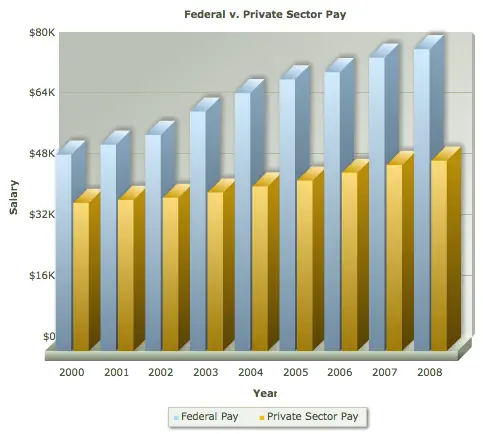According to the Bureau of Economic Analysis (an organization within the Department of Commerce), the average federal employee now makes $79,197, not including benefits. And, when benefits are added in, the average federal employee compensation averaged $119,982 based on 2008 figures.
Chris Edwards, the Director of Tax Policy Studies at the Cato Institute, has researched the Commerce Department figures and compared the average federal employee’s salary and benefits with the average private sector employee’s salary and benefits. No doubt, you will be reading about this in many local newspapers in the days and weeks to come.
The average private sector employee salary averaged $49,935. And, when including benefits, the average private sector employee averaged $59,909 in total compensation.
Stated differently, the benefit cost for the average federal employee back in 2008 was $40,785. The average benefit cost for private sector employees for the same year was $9974.
Here is a chart showing the relative pay levels from 2000 – 2008. By the way, I pulled the figures in this chart are from the tables by the Bureau of Economic Analysis. Any error in the figures should be attributed to me and not to Chris Edwards:
The pay gap with the private sector is not new. Federal employee salaries and total compensation has been higher than those in the private sector for a number of years. For example, Chris Edwards points out that back in 1990 the average federal employee salary was $32602 and the average private sector salary was $25857.
At that time, there was also a gap between the total compensation package. The average private sector employee had a benefits package with a value of $4852. The average federal employee had a benefit package with a value of $13894–a difference of $9042 in favor of the average federal employee. Now, as noted above, the difference in value of the total salary and compensation package is $60,073 in favor of the average federal worker.
Mr. Edwards notes that the compensation gap between private and federal workers actually grew larger during the Bush administration. He sums up the differential this way: “The result has been an increasingly overpaid elite of government workers, who are insulated from the economic reality of recessions and from the tough competitive climate of the private sector….At the same time, gold-plated federal benefit packages should be scaled back as unaffordable given today’s massive budget deficits. There are many qualitative benefits of government work—such as extremely high job security—so taxpayers should not have to pay for such lavish government pay packages.”
So what does this mean for the federal workforce?
A number of readers usually comment that the figures are misleading because federal employees don’t cook hamburgers and serve french fries at a fast food restaurant so that federal salaries should be higher than the average private sector worker.
There is certainly validity to that argument. But, for those who follow politics in America, you know that perception and political reality are often closely aligned. The current debate on health care, for example, has focused attention on the health care program offered to federal employees. A number of people speaking out on the issue have argued that everyone in America should have the same health care program as federal employees. How this would be paid for is usually not addressed. But that is an important issue since most of the cost of the health care for federal employees is paid by the government.
In short, federal benefits are quite good compared to the average American. In a time when the political philosophy seems to be leaning toward more equality of income and benefits, federal employee benefits could become a target at some point.
If that happens, we will keep readers informed, as we did with this recent article on proposals to reduce federal benefits.



